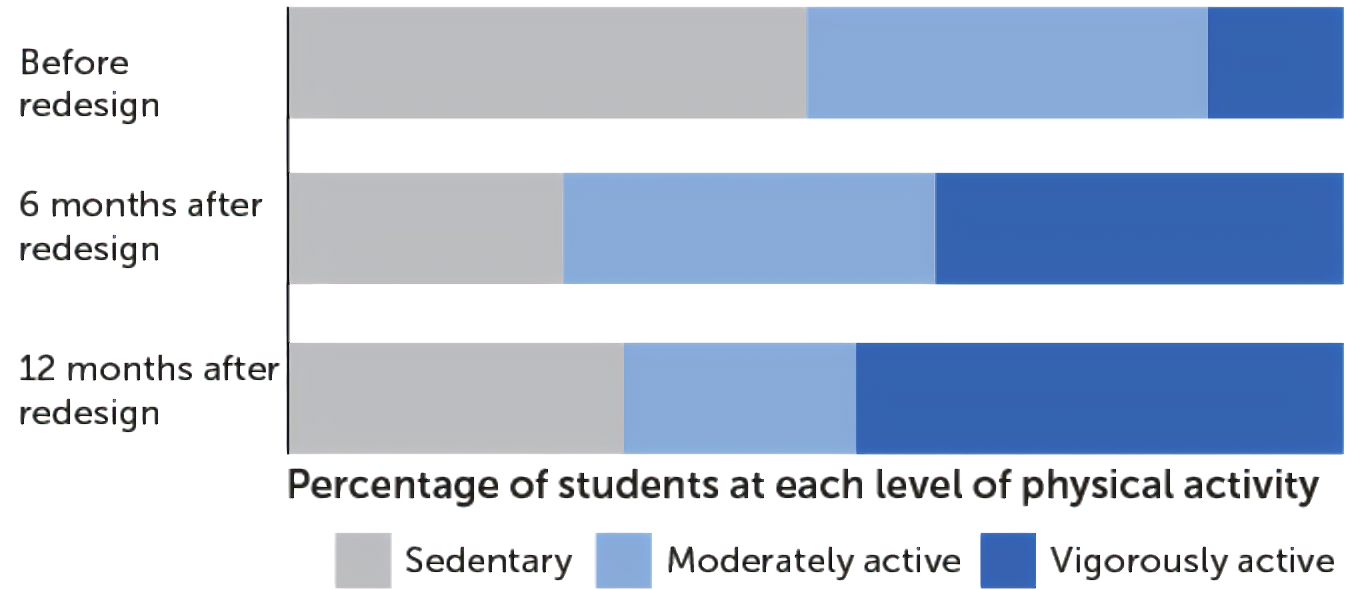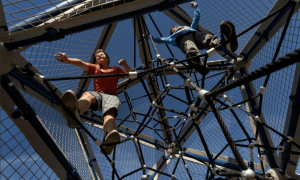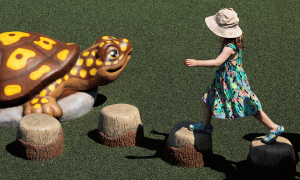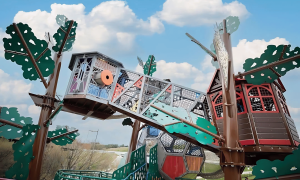What if the key to improving children’s health is sitting in parks and behind schools? A study from the American Journal of Preventive Medicine shows a playground's design is directly linked to how much a child engages in physical activity. The key is to create a playground that is appealing to children and encourages them to play longer.
Let’s look at the results of this study and explore ways to use playground equipment to create fun places for children to play and improve their health and wellness.
Replacing an Aging School Playground
At the heart of the AJPM study is a school playground. The students at the school barely played during recess. The outdated play equipment included a few swings, a rusting play structure, and an area filled with dirt and gravel.
No wonder the students weren’t playing very much!
The school removed the old playground and installed a colorful new play structure, a large net climber, new swings, slides, and more. The dirt and gravel were replaced with turf grass and walking paths. When the researchers came back to observe children on the new playground, what they found amazed them!
Helping Students Be More Active
When students saw the new playground, they were overjoyed! Suddenly, students who spent recess sitting on the ground or milling around in groups were playing again! The number of sedentary children during recess was cut in half, and the number of very active children tripled!

And this wasn’t one of those situations where a kid is happy with a birthday present for 15 minutes and then never plays with it again. Nope, in fact, the students continued to be active and use the playground in a similar way 12 months after it was installed.
The co-author of the study is Elena Kuo of Kaiser Permanente Washington Health Research Institute. She stated, “A lot of things, when they’re new and shiny, lead to increased physical activity, but it’s not always sustained. That’s why it’s a pretty exciting finding.”
How Playgrounds Improve Health and Wellness for Children
For decades, GameTime, and its parent company PlayCore, have researched the science behind play and recreation. Thanks to the PlayCore scholar network and partnerships with leading universities, we provide research and best practice design guides to help create better playgrounds - the same kind of playgrounds that got the students at this school up and playing again!
The research is clear. Children who are physically active on playgrounds are less likely to be overweight or obese. They are less likely to have weight-related health issues.
The World Health Organization recommends schoolchildren get 60 minutes of moderate to vigorous activity every day. Globally, 81 percent of children fail to reach that goal.
Children who actively play also see improvements in overall physical and mental health. They learn how to handle their emotions appropriately and develop empathy and social skills.
Yes, play is a huge deal!
Playgrounds Help Students Improve Their Grades
In schools, research shows students who are active during recess perform better academically. They are 20% more likely to earn an A in Math and English. And standardized test scores improve by six percent or more over three years.
Playful, active students are also better behaved. Just one physically active lesson each week reduces the amount of time teachers spend on behavior issues by 21%. Instead of calling down students for 12 minutes, they can drop knowledge for the entire hour-long class!
Six Essentials to Design the Perfect School Playground
The key to creating a successful school playground is using research from experts and play equipment children love. Play On! is a standards-based curriculum and design guide created by PlayCore in partnership with SHAPE America. It introduces six essential elements of play that should be included on a playground to keep children active.
These six essential elements are balancing, brachiating (overhead climbing), swinging, sliding, spinning, and climbing. When you design a play system or include freestanding play activities that provide all six elements, you turbocharge the play experience for students.
As a bonus, schools that use the research in Play On! receive a copy of the Play On! activity guide. This includes 125 fun activities for children in Pre-K through 5th grade. Each activity is designed to keep kids moving and transforms the playground into the best P.E. class ever!
Western Michigan University analyzed the Play On! program and found some exciting results!
- 91% of teachers reported that playground use increased
- 100% rated the program 4 or 5 on a 5 point scale
- 25% of parents participated in more family activity after the Play On! program was initiated
- 100% of students reported having fun engaging in the activities
- 90-100% of teachers said that Play On! motivated students to participate in regular, enjoyable, physical activity in a safe and supervised environment
I mean, come on! What school doesn’t want to see students motivated to play, move, and have fun?!
Partners to Help Plan Your School Playground
GameTime believes in school playgrounds. They are where children make friends, learn social skills, and learn active, healthy habits that last a lifetime. They also help students perform better in the classroom.
If you believe in school playgrounds too, we should talk! Get in touch with the GameTime school playground expert in your neighborhood today. Together, we’ll design a playground that students will love for years to come.





